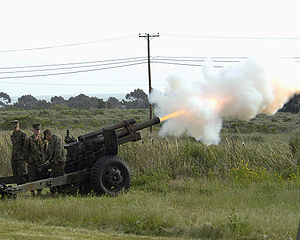M101A1
| M101A1 105 mm Howitzer | |
|---|---|

U.S. Marines fire a M101A1 howitzer during a ceremony in 2005
|
|
| Type | Howitzer |
| Place of origin | United States |
| Service history | |
| Used by |
|
| Wars |
World War II Korean War First Indochina War Vietnam War Insurgency in the Philippines |
| Production history | |
| Manufacturer | Rock Island Arsenal |
| Produced | 1941–1953 |
| Specifications | |
| Weight | 2,260 kg (4,980 lb) |
| Length | 5.94 m (19 ft 6 in) |
| Barrel length | 2.31 m (7 ft 7 in) L/22 |
| Width | 2.21 m (7 ft 3 in) |
| Height | 1.73 m (5 ft 8 in) |
|
|
|
| Shell | 105x372R |
| Caliber | 105 mm (4.1 in) |
| Breech | horizontal block |
| Recoil | hydropneumatic, constant, 42 in (110 cm) |
| Carriage | split trail |
| Elevation | -5° to +66° |
| Traverse | 46° |
| Muzzle velocity | 472 m/s (1,550 ft/s) |
| Maximum firing range | 11,270 m (7.00 mi) |
The 105 mm M2A1 (M101A1) howitzer was a howitzer developed and used by the United States. It was the standard U.S. light field howitzer in World War II and saw action in both the European and Pacific theaters. Entering production in 1941, it quickly gained a reputation for accuracy and a powerful punch. The M101A1 fired 105-millimetre (4.1 in) high explosive (HE) semi-fixed ammunition and had a range of 11,270 metres (12,330 yd), making it suitable for supporting infantry.
All of these qualities of the weapon, along with its widespread production, led to its adoption by many countries after the war. Its ammunition type also became the standard for many foreign countries' later models.
During the Second World War, U.S. artillery regiments consisted of an HQ detachment, one 155mm artillery battalion, and three 105mm artillery battalions. Both the 155mm and 105mm battalions had twelve guns each, divided into three batteries of four guns. That gave each regiment a total of twelve 155mm howitzers, and thirty six 105mm howitzers. With an HE M1 shell fired at 9000 meters, the probable error in range was 41 meters, while the probable error in line was 10 meters.
The U.S. military artillery designation system was changed in 1962, redesignating the 105mm M2A1 howitzer the M101A1. The gun continued to see service in the Korean and Vietnam Wars. Though a similar model, the M102 howitzer, shared the same roles in battle, it never fully replaced the M101A1. Today, the M101A1 has been retired by the U.S. military, though it continues to see service with many other countries. By the end of the Second World War, 8,536 105mm towed howitzers had been built and post-war production continued at Rock Island Arsenal until 1953, by which time 10,202 had been built.
The Canadian Forces continued to use the M2A1 as the C2 Howitzer until 1997, when a modification was made to extend its service life; it is now designated the C3. The changes include a longer barrel, a muzzle brake, reinforced trails and the removal of shield flaps. It remains the standard light howitzer of Canadian Forces Reserve units. The C3 is used by Reserve units in Glacier National Park in British Columbia as a means of avalanche control. In addition, the M101 has found a second use in the U.S. as an avalanche control gun, supervised by the US Forest Service.
...
Wikipedia
